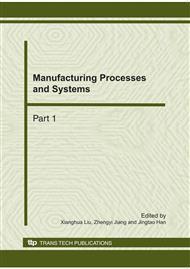p.103
p.108
p.112
p.118
p.126
p.130
p.136
p.141
p.147
Approximate Feedback Linearization Control for High Precision Hydraulic Parallel Machine Tool
Abstract:
Traditional feedback linearization approach (TFL) requires a priori knowledge of plant, which is difficult and the computational efficiency of controller is low due to complex dynamics of plant. In order to improve the tracking performance of hydraulic parallel machine tool and limit the drawbacks of TFL, a novel approximate feedback linearization approach is proposed in this paper. The mathematical models of hydraulic parallel machine tool are established using Kane method and hydromechanics. The approximate feedback linearization control is designed for the parallel machine tool in joint space, with the position and the stored data in the previous time step are employed, as a learning tool to yield improved performance. Under Lyapunov theorems, the stability of the presented algorithm is confirmed in the presence of uncertainties. Simulation results show the proposed control is readily and effective to realize path tracking, it exhibits excellent performance and high efficiency without a precision dynamics of plant. Moreover, the presented algorithm is well suitable for most industrial applications.
Info:
Periodical:
Pages:
126-129
Citation:
Online since:
October 2010
Authors:
Price:
Сopyright:
© 2011 Trans Tech Publications Ltd. All Rights Reserved
Share:
Citation:


